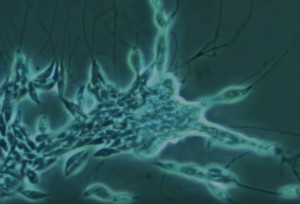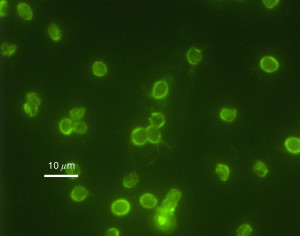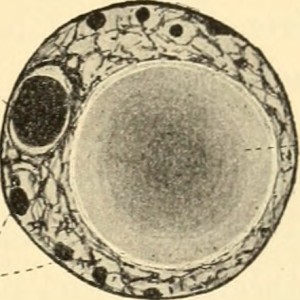by Kristen Minogue
Zebra mussels in the Great Lakes, lionfish in the Atlantic and pythons in the Everglades: Large creatures like these generally draw the spotlight when talking about ways to combat invasive species. But for every visible invader, there are hundreds more too minuscule to see with the naked eye. These species often slip in unnoticed—and unregulated—in the ballast water of large ships.
“There have been reports of parasites being transmitted in ballast water, but most of those have been things that we can easily see,” said Katrina Lohan, a marine biologist with the Smithsonian Environmental Research Center. “So, the parasites that are hanging off the outside of fish.”
Lohan has made it her mission to track the invisible invaders. Some are parasites that can infect humans, plants or other animals. Some can cause toxic algal blooms on the water’s surface. Many are impossible to identify even with a microscope, because single-celled microbes can look eerily (and, for biologists, exasperatingly) similar. And sometimes, a single parasite can take on many different forms throughout its life cycle.
Lohan is conquering these obstacles with DNA. In two of her most recent studies, she and a team of Smithsonian scientists took DNA samples from ballast water tanks of massive cargo ships. Marine vessels are one the most prevalent ways invaders cross the globe, as ships must often discharge microbe-infested ballast water after entering a new port. In a 2016 study, a team from SERC’s Marine Invasions Lab and the National Zoo looked for microscopic protists in ships entering Chesapeake Bay. One year later, in a study published in the June issue of Diversity and Distributions, the same team looked for protistan parasites entering ports on the East, West and Gulf Coasts of the U.S.
They discovered thousands of types of microbes lurking in the ballast water. DNA enabled the biologists to identify most of them to a genus (the level right before species). Some had never been detected in ballast water before, and some didn’t match anything on the books. The four groups below are just a few microscopic invaders that bear watching:
-

Slime net colony found on eelgrass near Washington State, likely Labyrinthula zosterae, the parasite behind seagrass wasting disesase. (Dan Martin/University of South Alabama)
The Labyrinthulids (a.k.a. “slime nets”)
Coated by a network of web-like ectoplasm, these protists have earned their more common moniker. “They really do look and move like slime nets,” Lohan said. “When you say that term and you look at it, and it’s just like this pulsing genuine net, and you can see the cytoplasm moving within the net—it’s really cool.” While not all slime nets are parasites, they have a stained record. One, Labyrinthula zosterae, is behind seagrass wasting disease, and others have caused diseases in corals and hard clams. Lohan’s team discovered over 150 different kinds of slime nets. One, called Labyrinthuloides haliotidis, kills young abalone shellfish by destroying tissue in their heads and feet. -

Hematodinium perezi in blue crab tissue
(Hamish Small & Jeffrey Shields, VIMS)The Syndinids
This order of parasitic dinoflagellates is famous for infecting fish, crustaceans and even other dinoflagellates. The syndinid Hematodinium perezi survives by infecting the tissues of blue crabs. The Smithsonian team found syndinids in ballast water for the first time in the 2016 study. In the 2017 paper, they detected six types of syndinids, two of which were abundant in every sample the team looked at. -

Cryptosporidium parvum, an apicomplexan that causes the disease cryptosporidiosis in humans. (HDALindquist/EPA)
The Apicomplexans
There are roughly 4,000 known species of Apicomplexans in the world, and they’re all parasites. Their ranks include the infamous Plasmodium, the agent behind malaria. Cryptosporidium struthionis, one of the species the Smithsonian team detected, causes disease in poultry. Lohan and the Smithsonian team also found an unknown species of gregarine, a worm-like protozoan that infects the digestive systems of invertebrates. -

Illustration of Dermocystidium pusula,
c. 1913 (Internet Archive Book Images)The Ichthyosporeans
This class includes the Dermocystidium parasites, notorious for infecting the gills of fish, and Rhinosporidium, a parasite that can cause lesions to grow on the eyes, nose or other body parts of some mammals and birds, including humans. All ichthyosporeans live with a “host” animal, but they aren’t all parasites. Some are mutualists that benefit their hosts, and some have commensalist relationships, neither helping nor harming their hosts. Like the syndinids, this group had never been detected in ballast water until the 2016 study, and some found in the 2017 study didn’t match any organisms known to science.
The world has woken up to the dangers of invasive species spreading through ballast water. In September of this year, the International Maritime Organization’s Ballast Water Management Convention is slated to go into full force, requiring ships to manage their ballast water for potential invaders. But according to Lohan, microbes aren’t included in the upcoming regulations, and the only parasites included are the cholera-inducing bacteria Vibrio cholerae.
And yet on planet Earth, microbes vastly outnumber visible species, and parasites vastly outnumber free-living ones. Perhaps it’s time to start giving the invisible organisms their due.





